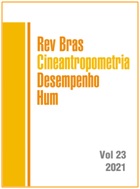Association between obesity and sedentary behavior in adults
DOI:
https://doi.org/10.1590/1980-0037.2021v23e75420Abstract
Although sedentary behavior (SB) is related to the development of metabolic diseases, there is still no consensus in literature about the association between accelerometer-based SB and obesity, especially adjusted for cardiovascular risk factors and level of daily physical activities. The aim was to evaluate the association between obesity and SB adjusted for potential confounders in adults. Data from 780 participants of the Epidemiology and Human Movement (EPIMOV) Study were analyzed. Body weight, body mass index (BMI), and fat body mass as percentage (%FBM) (bioelectrical impedance) were obtained and, then, used to stratify participants. SB was objectively measured using triaxial waist-worn accelerometers placed above the dominant hip during waking hours for at least four consecutive days (4-7 days). SB and its pattern were not significantly different between obesity groups. Although SB presented some significant correlations with obesity, the correlation and determination coefficient indicated weak association between SB and obesity (e.g., BMI and %FBM). Obesity presented little or no association with SB and its pattern after adjustment for potential confounders, especially when SB is measured through accelerometry.
References
Abelson P, Kennedy D. The obesity epidemic. Vol. 304, Science. Science; 2004. p. 1413.
Obesity and overweight [Internet]. [cited 2020 Jun 3]. Available from: https://www.who.int/news-room/fact-sheets/detail/obesity-and-overweight.
Hill JO, Wyatt HR, Reed GW, Peters JC. Obesity and the environment: Where do we go from here? Vol. 299, Science. Science; 2003. p. 853–5.
Physical activity guidelines advisory committee report, 2008: To the Secretary of Health and Human Services. Vol. 67, Nutrition Reviews. Nutr Rev; 2009. p. 114–20.
Owen N, Healy GN, Matthews CE, Dunstan DW. Too much sitting: The population health science of sedentary behavior. Exerc Sport Sci Rev. 2010 Jul;38(3):105–13.
Hamilton MT, Healy GN, Dunstan DW, Zderic TW, Owen N. Too little exercise and too much sitting: Inactivity physiology and the need for new recommendations on sedentary behavior. Curr Cardiovasc Risk Rep. 2008;2(4):292–8.
Schmid D, Ricci C, Leitzmann MF. Associations of objectively assessed physical activity and sedentary time with all-cause mortality in US adults: The NHANES study. PLoS One. 2015 Mar 13;10(3).
Hamilton MT, Hamilton DG, Zderic TW. Role of low energy expenditure and sitting in obesity, metabolic syndrome, type 2 diabetes, and cardiovascular disease. Vol. 56, Diabetes. Diabetes; 2007. p. 2655–67.
Methods of Measurement in Epidemiology: Sedentary Behaviour - PubMed [Internet]. [cited 2020 Jun 3]. Available from: https://pubmed.ncbi.nlm.nih.gov/23045206/.
Kim Y, Welk GJ, Braun SI, Kang M. Extracting Objective Estimates of Sedentary Behavior from Accelerometer Data: Measurement Considerations for Surveillance and Research Applications. Zanetta DMT, editor. PLoS One [Internet]. 2015 Feb 6 [cited 2020 Jun 3];10(2):e0118078. Available from: https://dx.plos.org/10.1371/journal.pone.0118078.
Revision of the Physical Activity Readiness Questionnaire (PAR-Q) - PubMed [Internet]. [cited 2020 Jun 3]. Available from: https://pubmed.ncbi.nlm.nih.gov/1330274/.
Pollock ML, Gaesser GA, Butcher JD, Després JP, Dishman RK, Franklin BA, et al. The recommended quantity and quality of exercise for developing and maintaining cardiorespiratory and muscular fitness, and flexibility in healthy adults. Vol. 30, Medicine and Science in Sports and Exercise. 1998. p. 975–91.
Boileau RA. Advances in body composition assessment. Cad Saude Publica. 1993;9(suppl 1):S116–7.
Campbell SDI, Brosnan BJ, Chu AKY, Skeaff CM, Rehrer NJ, Perry TL, et al. Sedentary Behavior and Body Weight and Composition in Adults: A Systematic Review and Meta-analysis of Prospective Studies. Vol. 48, Sports Medicine. Springer International Publishing; 2018. p. 585–95.
Curry WB, Thompson JL. Comparability of accelerometer- and IPAQ-derived physical activity and sedentary time in South Asian women: A cross-sectional study. Eur J Sport Sci. 2015 Oct 3;15(7):655–62.



